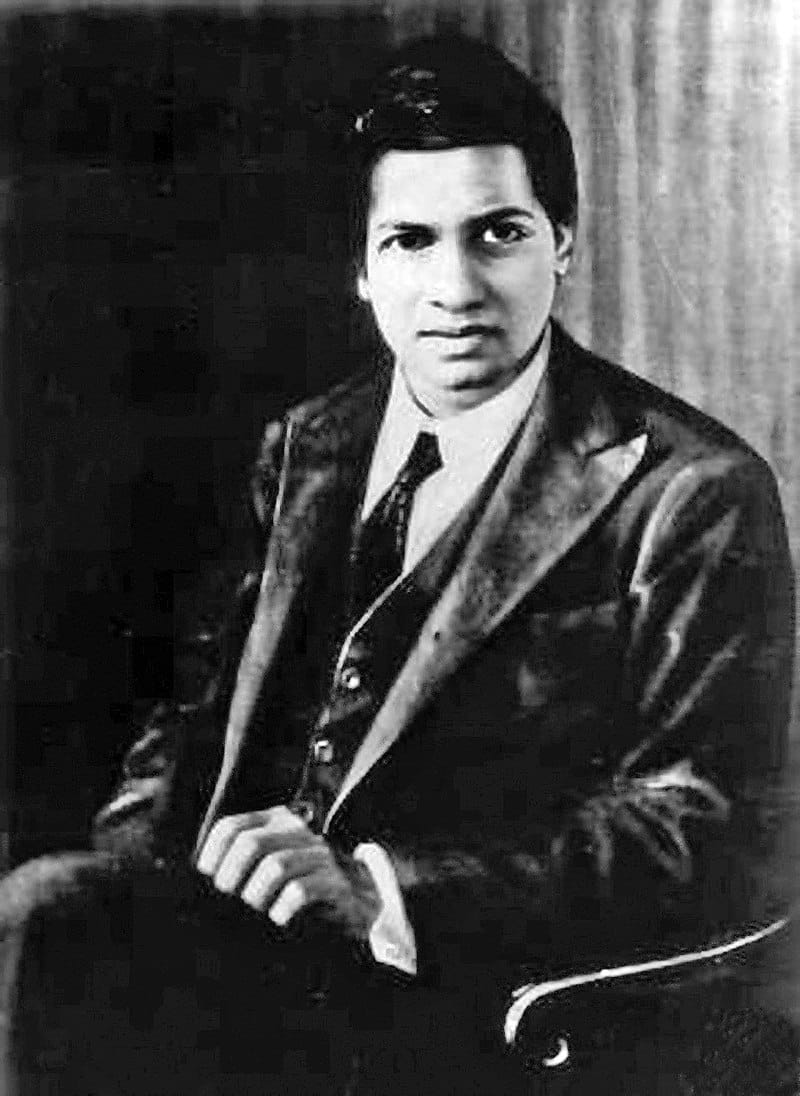Get ready to meet Srinivasa Ramanujan, an Indian mathematician whose mind worked in ways that continue to astound. Without the benefit of a traditional academic path, he made incredible discoveries that changed the world of mathematics forever. In this article, we’ll dive into the fascinating life and work of this self-taught genius, uncovering the secrets that made him one of history’s greatest mathematical minds.
Fascinating Facts About S. Ramanujan
Srinivasa Ramanujan’s story reads like a movie script—a young man in India, driven by an insatiable curiosity for numbers, teaching himself math and formulating mind-blowing theories without ever stepping foot in a university. He was a true self-made prodigy!
A Different Kind of Genius:
Ramanujan didn’t play by the usual rules of the math world. He didn’t have fancy degrees or prestigious mentorships; he possessed raw, undeniable talent. With unwavering confidence, he sent his work to renowned mathematicians—and they were floored. They immediately recognized his pure, unadulterated genius.
Numbers Like You’ve Never Seen Them Before:
Ramanujan wasn’t just solving math problems; he was uncovering hidden connections and patterns within numbers that had eluded mathematicians for centuries. It was as if he had a secret language with the universe of mathematics, leading him to groundbreaking discoveries, particularly in number theory. His fascination with infinite series—those never-ending strings of numbers—led to breakthroughs that forever changed our understanding of them.
The Mysterious Notebooks:
Imagine thousands of theorems and formulas, meticulously scribbled across countless pages—that’s what Ramanujan left behind in his notebooks. These notebooks are like treasure chests for mathematicians, filled with mind-boggling ideas that still have experts baffled. It’s as if he left us clues to a whole new level of mathematics, waiting to be deciphered. Decades later, researchers are still making new discoveries from these notebooks!
A Glimpse Inside a Unique Mind:
Legend has it that Ramanujan had vivid dreams about mathematical equations. These dreams often sparked his biggest breakthroughs, adding another layer of intrigue to his captivating story. He preferred working alone, his unconventional methods, and solitary nature, only adding to his mystique.
A Legacy That Inspires:
Ramanujan’s impact on the world of math is immeasurable. His work, translated into over 20 languages, continues to inspire new generations of mathematicians globally. His life has been the subject of countless books, films, and plays—a true testament to the enduring power of his story.
What are the unique facts about Ramanujan?
Srinivasa Ramanujan defied the stereotype of a typical mathematician. This self-taught prodigy from India navigated the world of numbers with an almost mystical intuition, making groundbreaking discoveries despite struggling to afford formal education.
What made Ramanujan truly unique was his unconventional approach. While most mathematicians rely on established methods, he used his incredible intuition to unlock hidden patterns and connections within numbers. Imagine seeing a secret world of mathematics that others couldn’t even comprehend! He developed his own unique notations and formulas, which initially proved difficult for other mathematicians to decipher—like trying to read a book in an unknown language.
His insights, however, were incredibly powerful and accurate. Some experts believe that his unconventional approach was influenced by his deep connection to mysticism and spirituality, adding a fascinating dimension to his mathematical explorations.
Despite his lack of formal training, Ramanujan made significant contributions to mathematics, particularly in the areas of infinite series, continued fractions, and the partition function formula. His work, still studied and admired today, has real-world applications in fields like quantum mechanics and statistical physics.
Ramanujan’s ability to work independently, without the guidance of established mathematicians, is a testament to the power of human curiosity, perseverance, and the boundless potential of the human mind. His legacy continues to inspire mathematicians and researchers worldwide, reminding us that the most unconventional paths can lead to the most extraordinary discoveries.
Further Exploration:
- The Man Who Knew Infinity: This captivating book and the film based on it offer a glimpse into Ramanujan’s life and work.
- Ramanujan’s Notebooks: Filled with thousands of his mathematical results and conjectures, these notebooks continue to fascinate and challenge mathematicians.
Remember, the study of mathematics is an ongoing journey, and there’s still so much we don’t know.
What about Ramanujan in 10 points?
Srinivasa Ramanujan, a name synonymous with extraordinary mathematical prowess, continues to intrigue and inspire. Here are 10 key insights into his life and work:
1. A Natural When It Came to Numbers
Numbers were Ramanujan’s native language. He didn’t need fancy degrees; his understanding of mathematical principles was innate and effortless. He devoured math books, filling notebooks with his own unique ideas and insights.
2. Changing the Game of Math
Ramanujan tackled areas like number theory, infinite series, and continued fractions in ways that had never been imagined before. His work was groundbreaking, like discovering new continents on the map of mathematics.
3. Breaking the “Rules” Brilliantly
Ramanujan’s intuition often led him to incredible results, even if his methods defied traditional mathematical rigor. His ability to think outside the box led to some of his most significant breakthroughs.
4. His Influence Still Echoes Today
Ramanujan’s legacy is profound. His ideas, still studied and explored today, continue to push the boundaries of mathematics, influencing research and inspiring new generations of mathematical minds.
5. A Self-Made Math Whiz
Lacking formal training in advanced mathematics, Ramanujan essentially taught himself, fueled by his passion and insatiable curiosity for the world of numbers. His dedication and self-directed learning made him a true anomaly.
6. Teaming Up with a Math Superstar
G.H. Hardy, a leading mathematician of the time, recognized Ramanujan’s genius. Their collaboration was a meeting of minds, providing the support and structure Ramanujan needed to share his gifts with the world.
7. Math Whispered to Him
Ramanujan often described his mathematical insights coming from a deeply intuitive, almost spiritual place. Equations and solutions appeared to him in dreams or moments of deep contemplation, as if the secrets of numbers revealed themselves to him.
8. Did His Culture Play a Role?
Some experts speculate that Ramanujan’s unique approach to math may have been influenced by ancient Indian mathematical traditions, which often blended logic with philosophical and religious ideas.
9. Secrets Yet to Be Unlocked
Some of Ramanujan’s writings are still being analyzed today. His notebooks, filled with unique scribbles and complex equations, could hold even more groundbreaking discoveries, waiting to be deciphered.
10. A Life Cut Tragically Short
Ramanujan’s brilliance was extinguished far too early. He died at the age of 32. His legacy, however, continues to inspire awe and wonder, leaving us to imagine the countless other mysteries he might have unraveled had he lived longer.
How many hours does Ramanujan sleep?
Ramanujan’s work habits were as unusual as his mathematical discoveries. We’re not talking about pulling an all-nighter; we’re talking about taking intense focus to a whole new level! When engrossed in his calculations, he would work for stretches as long as 30 hours straight, pushing his mind to the limit.
After these marathon thinking sessions, he would crash, sleeping for up to 20 hours to recover. It appears his brain needed significant downtime after such intense activity—like a mental marathon requiring a serious nap!
Whether this unusual sleep pattern contributed to his genius is unknown. However, some experts believe these extended periods of rest may have allowed his brain to process those complex mathematical ideas. It’s like his subconscious mind continued working on the problems even while he slept.
While we may be merely speculating, Ramanujan’s story reminds us that we all have unique rhythms and ways of working. What works for one person may not work for another, and that’s okay!
What was Ramanujan’s IQ?
While Ramanujan’s exceptional mathematical talents are undeniable, he never took an IQ test. It’s like trying to guess a baseball player’s batting average without ever seeing them at bat—we simply don’t have that specific data point.
However, considering his incredible mathematical discoveries and his unique ability to grasp the intricacies of numbers, experts have estimated his IQ to be somewhere between 165 and 200. To put this into perspective, the average person scores around 100. Ramanujan was operating on an entirely different level of cognitive ability.
What makes this even more fascinating is that he was largely self-taught. This unconventional path may have actually been advantageous, allowing him to see math problems from completely unique angles and discover solutions others hadn’t even considered.
His expertise in number theory, which deals with the properties and relationships between numbers, was particularly profound. Some believe his extraordinary talent in this area suggests an IQ potentially even higher, perhaps between 185 and 200.
While we may never know his exact IQ, the numbers themselves don’t fully encompass his genius. His legacy lies in the groundbreaking contributions he made to mathematics, forever changing how we understand the language of the universe.
What is the mystery of Ramanujan?
Srinivasa Ramanujan’s brilliance was undeniable, but the how behind his mathematical breakthroughs remained a mystery. It’s as if he possessed a secret code to the universe of numbers that no one else could decipher.
Imagine teaching yourself advanced mathematics – that’s precisely what Ramanujan did. Driven by an unquenchable thirst for knowledge, he immersed himself in any math book he could find, ultimately discovering mind-blowing theorems and formulas. Even seasoned mathematicians were left baffled, wondering, “How did he come up with that?”
Adding to the enigma, Ramanujan wasn’t always concerned with explaining the steps or the logic behind his mathematical leaps. He would often present complex conclusions as if they arrived fully formed, leading some to believe his work was guided by vivid dreams and visions. The image of his brain solving equations while he slept only adds to the intrigue surrounding this enigmatic figure.
Enter G.H. Hardy, a renowned British mathematician, who received a letter from Ramanujan filled with unconventional mathematical ideas. Recognizing the genius within those pages, Hardy invited Ramanujan to Cambridge University. This partnership, a meeting of extraordinary mathematical minds, provided Ramanujan with a platform to delve deeper into his research, leading to even more groundbreaking findings.
Tragically, Ramanujan’s life was cut short at the age of 32. However, his work continues to resonate through the halls of mathematics today. Discoveries like “Ramanujan primes” and “mock theta functions” are still being studied and explored, unlocking new ways of looking at math.
Ramanujan’s process, his intuition, his unique approach—they all remain a captivating enigma, reminding us that mysteries still abound, especially in the world of numbers. Perhaps someday, someone will crack the code of Ramanujan’s genius.
What is the fact check 2520 Ramanujan?
Srinivasa Ramanujan, the mathematical prodigy from India, never ceased to amaze with his intuitive grasp of numbers. In a letter to G.H. Hardy, a leading mathematician in Britain, Ramanujan made a statement about the number 1729, claiming it was the smallest number that could be expressed as the sum of two cubes in two different ways. Impressed by Ramanujan’s insights, Hardy invited him to collaborate in Cambridge.
But Ramanujan’s ability to reveal hidden patterns within numbers didn’t stop there. He later proved a fascinating fact about the number 2520. This number holds a special place in mathematics as the smallest number that can be expressed as the sum of two cubes in three different ways! This mind-boggling discovery is now often referred to as the Ramanujan-Hardy number, showcasing Ramanujan’s incredible mathematical intuition.
This intriguing fact highlights Ramanujan’s ability to see relationships and patterns within the world of numbers that had eluded others. It’s a testament to his unique way of thinking and his ability to push the boundaries of mathematical understanding.
What is the uniqueness of 1729?
The number 1729, often called the Hardy-Ramanujan number, holds a special place in the world of math. It’s the smallest number that can be expressed as the sum of two different sets of cubed numbers.
Here’s the breakdown: 1729 can be obtained by adding 10 cubed (10 x 10 x 10) and 9 cubed (9 x 9 x 9). But what makes it truly unique is that you can also get 1729 by adding 12 cubed (12 x 12 x 12) and 1 cubed (1 x 1 x 1). It’s like finding a hidden magic trick within the world of numbers!
Srinivasa Ramanujan’s recognition of this seemingly simple fact about 1729 highlights his incredible understanding of numerical relationships. It reveals a beautiful and unexpected pattern, reminding us that even within the realm of numbers, there’s always something new to discover. It’s like finding a hidden connection that deepens our appreciation for the elegance of mathematics.
While we may not use this fact in our daily lives, the story of 1729 serves as a reminder that there are hidden patterns and connections all around us, waiting to be discovered.
What are the strengths of Ramanujan?
Srinivasa Ramanujan’s exceptional abilities extended beyond his raw mathematical talent. His strengths were multifaceted, shaping his unique approach to the world of numbers.
Thinking Differently, Seeing the Unseen
Ramanujan possessed an exceptional intuitive grasp of mathematics. It was as if he could look at a complex problem and instinctively know the answer, even if he couldn’t immediately explain the path that led him there. Like a musician hearing a melody in their head before transcribing it onto paper, Ramanujan’s theories were highly original, often solving mathematical mysteries that had stumped others for generations.
A Passion for Learning, Against All Odds
Ramanujan’s journey was marked by incredible determination. He faced numerous setbacks due to his lack of traditional education, yet his passion for learning never wavered. He was a self-taught genius, driven by an insatiable hunger for knowledge. Picture him spending countless hours poring over books, teaching himself advanced mathematical concepts—a testament to the power of dedication and a pure love for learning.
Breaking the Mold, Redefining the Rules
Unafraid to challenge the status quo, Ramanujan questioned established mathematical methods, forging new paths and uncovering hidden patterns. He developed his own unique ways of writing and thinking about mathematics—an approach that wasn’t always initially understood or appreciated. Like a painter who disregards the rulebook to create a new artistic style, Ramanujan wasn’t afraid to break the mold and explore uncharted territory.
A Catalyst for Collaboration
While his ideas were often unconventional, their brilliance attracted the attention of some of the best mathematicians of his time, including G.H. Hardy. Their collaboration sparked a wave of new research and discoveries. It’s as if he cast a stone into a pond, and the ripples spread outward, inspiring others to see mathematics in a whole new light.
Ramanujan’s legacy continues to be studied and debated today. His impact on mathematics is undeniable, even though some aspects of his work remain enigmatic.
If you want to delve deeper into the life of this extraordinary mathematician, you can explore his biography here.
What are the famous results of Ramanujan?
Srinivasa Ramanujan’s lack of formal training didn’t hinder his ability to make groundbreaking discoveries in mathematics. His work continues to astound and inspire, revealing a depth of understanding that transcends traditional boundaries.
Ramanujan Primes: A Special Kind of Prime Number
Imagine listing out all the prime numbers, from smallest to largest. Now, add up all those primes. A Ramanujan prime is even more exceptional—it’s a prime number larger than the sum of all the primes smaller than itself. They are like the overachievers of the prime number world!
The Ramanujan Theta Function: Like a Mathematical Orchestra
Think of the Ramanujan theta function as a beautiful, never-ending melody in the language of mathematics. This “infinite series,” a pattern of numbers that continues indefinitely, plays a vital role in various mathematical disciplines, including physics, statistics, and geometry. It’s as if this single function harmonizes with countless mathematical symphonies.
Mock Theta Functions: The Illusionists of Math
“Mock theta functions” add a layer of complexity and intrigue. Like a magician’s illusions, these functions appear to belong to one group of mathematical objects (theta functions) while simultaneously sharing traits with another (modular forms). They have puzzled mathematicians for years and continue to be a subject of ongoing research.
The Hardy-Ramanujan Formula: Counting the Uncountable
Have you ever considered how many ways you can break down a number into smaller whole numbers? For instance, 4 can be split into: 1+1+1+1, 1+1+2, 1+3, 2+2, or just 4. That’s five different ways! The Hardy-Ramanujan formula helps mathematicians estimate how many ways they can split very large numbers—a task that becomes incredibly complex very quickly.
Rogers-Ramanujan Identities: Connecting the Dots in the Pattern
These identities are like deciphering secret codes, revealing hidden connections between different parts of the mathematical universe. They link together the coefficients—those small numbers in front of variables—in specific “modular forms,” which are fundamental to higher-level mathematics.
The Legacy of Ramanujan: A Wellspring of Inspiration
And these are just a few of Ramanujan’s contributions. His notebooks are filled with countless formulas and theorems that researchers are still diligently trying to understand. His work continues to inspire mathematicians today, demonstrating that true genius can emerge from the most unexpected places, challenging our understanding of the world and pushing the boundaries of human knowledge.
Just the Beginning:
We’ve only scratched the surface. The world of mathematics is vast, and there’s always more to explore. Don’t be afraid to delve deeper into the mysteries that pique your interest. You never know what amazing discoveries await!
Who discovered 0?
The story of zero is a fascinating journey through time and across cultures. It wasn’t a sudden discovery but a gradual evolution of ideas that spanned centuries.
Over 4,000 years ago, the Sumerians used empty spaces in their number systems, acting as placeholders for absent values. Later, the Babylonians developed a sophisticated number system based on the number 60, using small wedge shapes to differentiate magnitudes—a concept similar to how we use zero in our decimal system.
However, it was in 7th century AD India that zero truly emerged as a mathematical concept. The mathematician Brahmagupta didn’t just use zero as a placeholder; he recognized it as a number in its own right, giving it the name “sunya.” Brahmagupta defined zero’s properties, showing how subtracting a number from itself results in zero. His work laid the foundation for a revolution in mathematics.
The concept of zero then journeyed eastward to China and westward to the Middle East, spread by trade and cultural exchange. In the 8th century, the Persian mathematician al-Khwarizmi introduced zero to the Western world as an integral part of his revolutionary algebraic equations, which he called “al-jabr”—the root of the word “algebra” we use today.
By the 12th century, thanks to the work of the Italian mathematician Fibonacci, zero arrived in Europe and gained widespread acceptance. Luminaries like René Descartes, Isaac Newton, and Gottfried Leibniz embraced zero, incorporating it into their groundbreaking work, further solidifying its importance in science, economics, and mathematics.
Today, zero is indispensable. It’s not just the heart of our number system; it’s a powerful concept that has shaped our understanding of nothingness, infinity, and the vastness of the universe. Zero’s influence extends far beyond mathematics, prompting us to contemplate profound questions about existence and the nature of reality.
Key Takeaways:
- Zero has a rich and complex history, emerging from ancient civilizations over time.
- Brahmagupta, a 7th-century Indian mathematician, played a crucial role in recognizing zero as a number with its own unique properties.
- Al-Khwarizmi introduced zero to the Western world through his groundbreaking work in algebra.
- Fibonacci, the Italian mathematician, brought zero to Europe in the 12th century.
- Zero’s significance extends beyond its mathematical applications, influencing our understanding of philosophy, nothingness, and the universe itself.
- Dive into a fascinating escapade where you’ll discover surprising facts about Steve Cohen.
- The enigmatic world of Erich Honecker unfolds before you with astounding facts that will redefine your perception of history.
- And for the ardent MMA enthusiast, uncover facts about Tony Ferguson that will ignite your passion for the Octagon.
- Crypto Quotes’ Red Flags: Avoid Costly Mistakes - June 30, 2025
- Unlock Inspirational Crypto Quotes: Future Predictions - June 30, 2025
- Famous Bitcoin Quotes: A Deep Dive into Crypto’s History - June 30, 2025
















